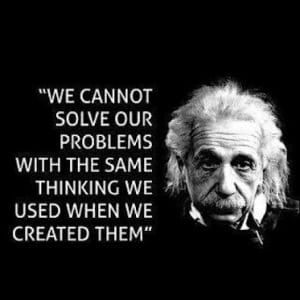 How committed are you to becoming a successful trader? Are you ready to make meaningful changes to your approach—even if it requires a complete shift in how you think about trading?
How committed are you to becoming a successful trader? Are you ready to make meaningful changes to your approach—even if it requires a complete shift in how you think about trading?
Change can be challenging; it involves setting aside ego, pride, and even some comfort. However, the truth is that embracing change is the first crucial step to breaking away from unproductive trading habits that have held you back and steering toward a path of consistent success.
After reading this article and adopting a new mindset, you’ll likely notice a meaningful transformation in both your trading performance and experience.
Shift Your Mindset on Trading
 A common pitfall for traders is becoming too emotionally attached to a single trade. In reality, each trade should carry zero emotional weight.
A common pitfall for traders is becoming too emotionally attached to a single trade. In reality, each trade should carry zero emotional weight.
For instance, imagine your trading strategy has a 60% win rate. Here’s what that really means:
What a 60% win rate does mean: Over a large number of trades, you can expect to win about 60% of them.
What it doesn’t mean: It does not imply that any single trade has a 60% chance of winning.
Many traders mistakenly believe that a trade they’re about to make is highly likely to be a winner, given their edge. This misunderstanding can lead to unrealistic expectations for each individual trade.
To illustrate, think of a jar filled with 100 marbles: 60 blue and 40 red. Each marble represents a trade—blue marbles for winners, red for losers. So, a 60% win rate means 60 blue marbles out of 100. But if you shake the jar and reach in blindly, you don’t know if you’ll pull out a red or blue marble. You wouldn’t assume every marble drawn will be blue just because they’re in the majority, would you?
This is how you should view your trades: as random events. Even if you expect to win 60% over time, any individual trade could go either way. When you accept this, you’ll stop assigning unnecessary emotional weight to individual trades, which can clear the path for a healthy, confident trading mindset.
When you let go of expectations and attachment to single trades, you naturally improve your process. You start managing risk properly and stop interfering with trades mid-course because you understand each setup has no guarantee. Instead, you’re focused on letting your trading edge play out over a series of trades. This way, you’re free to risk only what you’re comfortable losing, letting the market take its course without becoming over-involved or stressed.
Think in Probabilities to Avoid Emotional Strain
Imagine playing a slot machine. Each pull of the lever is random, and you have no specific expectation of winning or losing. This mindset aligns your expectations with the randomness of the game.
In trading, however, it’s easy to let past successes with a particular pattern build expectations that it will work again. But this mindset sets you up for disappointment and frustration. Each trade is an independent event with an outcome that is unrelated to previous trades. Just because a pin bar pattern was profitable before doesn’t guarantee it will be again, even if it looks identical.
The outcome of any single trade is random. Each trade you take is separate from the one before or after it. Whether this trade wins or loses, the next trade could go either way. If your trading edge has a 60% win rate, remember that this success rate is realized over a series of trades, which may include streaks of losses or wins. Having 5 or even 10 losses in a row doesn’t mean the strategy is broken—it’s just part of the probabilities at play. Your goal is to stick to your plan and keep trading consistently to see your edge materialize over time.
To avoid market disappointment, shift your goal from trying to be “right” on each trade to understanding that each trade is just one draw in a probability game. Think back to the jar of red and blue marbles: each time you trade, you’re reaching into the jar, knowing you could pull out a winner (blue marble) or a loser (red marble). Don’t expect a blue marble every time—just know that over many trades, you’ll end up with about 60% blue (winners) and 40% red (losers).
By adopting this probability-based mindset, you align your thinking with how the market truly operates. This way, you set yourself up to benefit from the market’s natural dynamics rather than being thrown off balance by individual outcomes.
How to Eliminate Trading Mistakes and Start Profiting
 Most blown trading accounts result from a snowball effect of compounding mistakes. It often starts with getting too attached to a trade that seems “perfect”—one you believe “can’t fail.” You double or triple your risk, aiming for a big win. When the trade doesn’t go as planned, you experience a strong emotional reaction, leading to frustration and even anger. This can kick off a cycle of impulsive decisions: entering another trade immediately with even more risk, hoping to recover the loss. This cycle can quickly lead to an account wipe-out.
Most blown trading accounts result from a snowball effect of compounding mistakes. It often starts with getting too attached to a trade that seems “perfect”—one you believe “can’t fail.” You double or triple your risk, aiming for a big win. When the trade doesn’t go as planned, you experience a strong emotional reaction, leading to frustration and even anger. This can kick off a cycle of impulsive decisions: entering another trade immediately with even more risk, hoping to recover the loss. This cycle can quickly lead to an account wipe-out.
The key to avoiding this downward spiral is a shift in mindset. By approaching each trade as a probability rather than a “sure thing,” you sidestep the main trap that causes most traders to lose money: unrealistic expectations.
Think back to when you were demo trading. Like many traders, you probably did well because you had the right mindset—there was no real money on the line, so each trade felt low-stakes, and you didn’t dwell on whether it won or lost. This is the mindset to aim for in live trading. The trick is to avoid attaching your emotions to any single trade by focusing on the bigger picture of probabilities.
When you adopt this perspective, you’ll be far better positioned to make steady, consistent gains in the market, and emotional mistakes will no longer stand in the way of your success.

